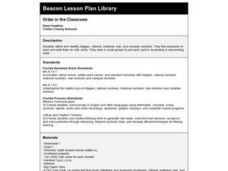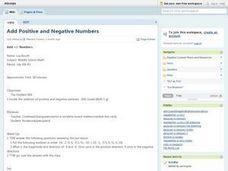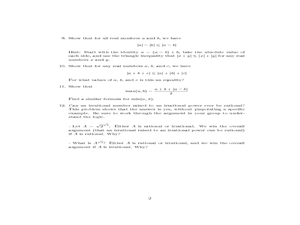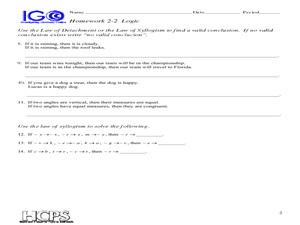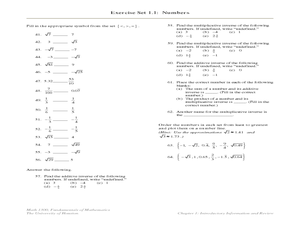Curated OER
Number Theory and The Real Numbers
In this algebra learning exercise, 9th graders define rational and irrational numbers and answer questions about properties of real numbers. There are 38 questions on this test.
Curated OER
Irrational Numbers
In this irrational numbers worksheet, 9th graders solve 10 different problems that include determining the approximations of various irrational numbers. First, they solve each irrational number in the first set to the nearest tenth....
Curated OER
Signed Numbers
In this signed numbers worksheet, 6th graders solve and complete 4 different types of problems. First, they calculate each problem using a number line. Then, students solve each word problem as indicated.
Curated OER
Simplify Radicals
Learners are introduced to the concept of radicals and how to use them in various situations. They review rational and irrational numbers while simplifying different number sentences. They also practice factoring perfect squares.
Curated OER
Order in the Classroom
First graders define and identify integers, rational, irrational, real, and complex numbers. They place number cards in ascending and descending order.
Illustrative Mathematics
Converting Decimal Representations of Rational Numbers to Fraction Representations
A rational number is a ratio of two integers. Discuss with your class how to convert the rational numbers of repeating decimals to fractions. A good commentary on letting x equal the repeating decimal and multiplying each side of...
Illustrative Mathematics
Placing a Square Root on the Number Line
There are many ways to approach finding the rational approximation of an unknown square root. Here is a problem that will help math learners make a connection between square roots and their order on a number line. As usual, determine two...
Curated OER
A Slice of Pi
Math pupils, by viewing a video, discover the history of pi and some of the applications of its uses in the world today. They conduct an experiment by measuring the diameter and circumference of various circular objects to calculate...
Curated OER
Discriminating Against the Zero
Students explore the concept of quadratic equations. In this quadratic equations lesson plan, students find the roots or zeros of quadratic equations using the quadratic formula. Students give examples of functions with 2...
Curated OER
Lesson 2 Ordering Numbers
Math wizards begin the lesson by comparing and ordering rational numbers. Using a number line, they discover the relationship between the numbers and practice ordering them in the correct way. They also review proper techniques for...
Curated OER
Add Positive And Negative Numbers
Scholars investigate the concept of adding positive and negative numbers. They practice adding using the number line for scaffolding. This can be done as a game for younger learners, but may also be helpful for engaging the older pupils.
Curated OER
Does the Decimal Point Really Make a Difference?
Fourth graders study the decimal dilemma and discover major math mistakes in the real world with cheeseburgers advertised for .99 cents each or colas for .89 cents each.
Benjamin Franklin High School
Saxon Math: Algebra 2 (Section 1)
This first of twelve algebra 2 resources provides a broad review of many algebra 1 concepts through a number of separable lessons and labs. Starting with the real number system and its subsystems, the sections quickly but thoroughly...
Ohio Department of Education
Number Subsets: Winning the Number Game - Grade Eight
Young leearners identify subsets of the real number system and play a number game to identify natural numbers, whole numbers, integers, rational and irrational numbers.
EngageNY
Using the Quadratic Formula
What is the connection between the quadratic formula and the types of solutions of a quadratic equation? Guide young mathematicians through this discovery as they use the discriminant to determine the number and types of solutions,...
EngageNY
Applications of the Pythagorean Theorem
Begin seeing the world through the lens of geometry! Use the 19th installment in a 25-part module to apply the Pythagorean Theorem to solve real-world problems. Individuals sketch situations resulting in right triangles such as the...
Curated OER
Squares and Square Roots II
Pupils evaluate squares and square roots. Through practice, they discover the inverse relationship between squares and square roots. Students take notes, solve square root and square root problems, and classify numbers as rational or...
Curated OER
Do You Have Number Sense?
Seventh graders are grouped according to their ability level with a captain who is elected by the students in that particular group. Students demonstrate their knowledge of rational and irrational numbers by defining them. Students use a...
Curated OER
Math 32 Worksheet: Quadratic Equations
For this quadratic equations worksheet, students solve 12 short-answer problems. Students find real and irrational solutions to given functions. Students raise irrational numbers to irrational powers.
Curated OER
Meter Marker Mania
Students identify integers as rational and irrational numbers. In this algebra instructional activity, students measure and construct number lines using positive and negative integers. They convert between decimals and fractions.
Curated OER
Logic Homework
In this algebra worksheet, learners use Venn diagrams to differentiate between rational and irrational numbers. They solve word problems using algebraic expressions. There are 14 questions.
Cabrillo College
Elementary Algebra
Hello Algebra! If you're in need of a resource with a books worth of examples and practice problems, this is it. Some topics include linear equations, polynomials and exponents, rational expressions, quadratic equations, and a...
Curated OER
Numbers 1.1
In this numbers 1.1 worksheet, pupils solve 64 problems about all kinds of numbers: rational, irrational, prime, composite, square roots, fractions, decimals.
Curated OER
Numbers, Numbers Everywhere!
Explore properties of integers! In this algebra lesson, pupils add, subtract, divide and multiply using integers correctly. They differentiate between rational and irrational numbers.




